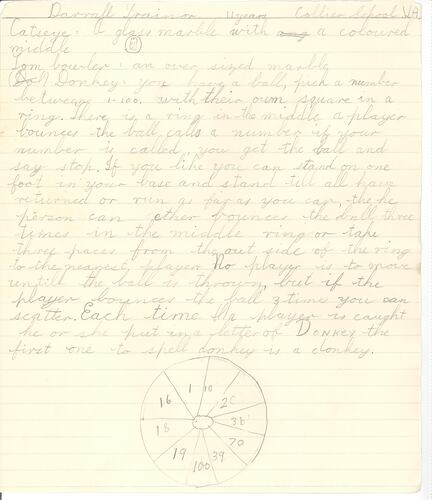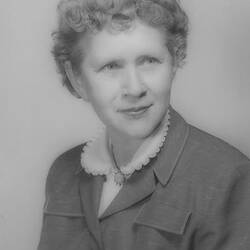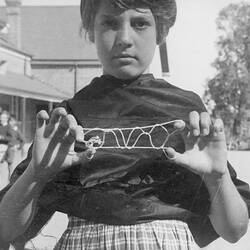Summary
Game name (and type): 'Donkey' (ball game); (marbles)
Alternative types: ball bouncing games, play with props/equipment
Game terminology: 'Catseye', 'Tom Bowler'
Handwritten descriptions of terminology used in marbles games and the ball game 'Donkey' written for Dr Dorothy Howard by Darrall Trainor, a student at Collier Primary School, in 1955. Trainor describes a 'catseye' as a glass marble with a coloured middle and a 'Tombowler' as an oversized marble, providing a small, hand drawn illustration of the former. He continues with a detailed description of how the ball bouncing game 'Donkey' is played, including a hand drawn diagram of the game's circular configuration. The game's rules are slightly unclear; however, it appears that players select a numbered division within the circle while another player, 'He', stands in the small, central circle and bounces a ball. It seems that particular actions executed by 'He', for example a certain number of ball bounces, require the other players to scatter or remain still. Each time a player is caught out, they accumulate a letter from the word 'DONKEY'.
One of a collection of letters describing a children's games written to children's Folklorist Dorothy Howard between 1954 and 1955. Dr Howard came to Australia in 1954-55 as an American Fulbright scholar to study Australian children's folklore. She travelled across Australia for 10 months collecting children's playground rhymes, games, play artefacts, etc. This letter, together with the other original fieldwork collected by Dr Howard during this period, is preserved in the Dorothy Howard Collection manuscript files, part of the Australian Children's Folklore Collection (ACFC), Archive Series 3. The ACFC is an extensive collection documenting children's folklore and related research.
Physical Description
Handwritten game descriptions in pencil on lined paper. Features a large hand drawn diagram on lower portion of page; a smaller hand drawn diagram is located amongst the text on upper portion of page. Text printed on one side only.
More Information
-
Collection Names
Australian Children's Folklore Collection, Dorothy Howard Collection
-
Collecting Areas
-
Acquisition Information
Cultural Gifts Donation from Dr June Factor, 18 May 1999
-
Acknowledgement
Donated through the Australian Government's Cultural Gifts Program.
-
Author
Darrall Trainor - Collier Government Primary School, Perth, Western Australia, Australia, 1955
-
Addressed To
-
Collector
-
Organisation Named
Collier Government Primary School, Perth, Western Australia, Australia
-
Classification
-
Category
-
Discipline
-
Type of item
-
Overall Dimensions
214 mm (Width), 248 mm (Height)
Orientation: portrait
-
Keywords


